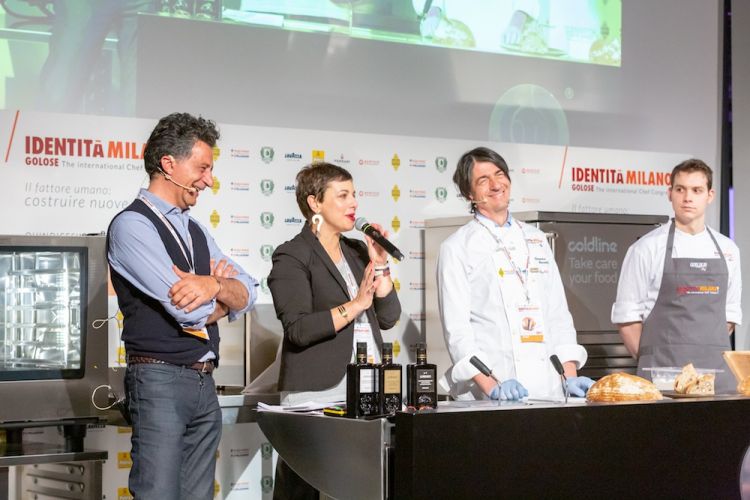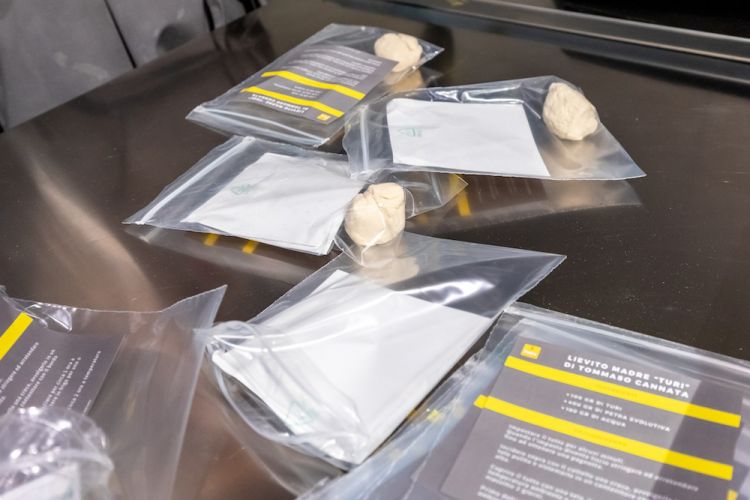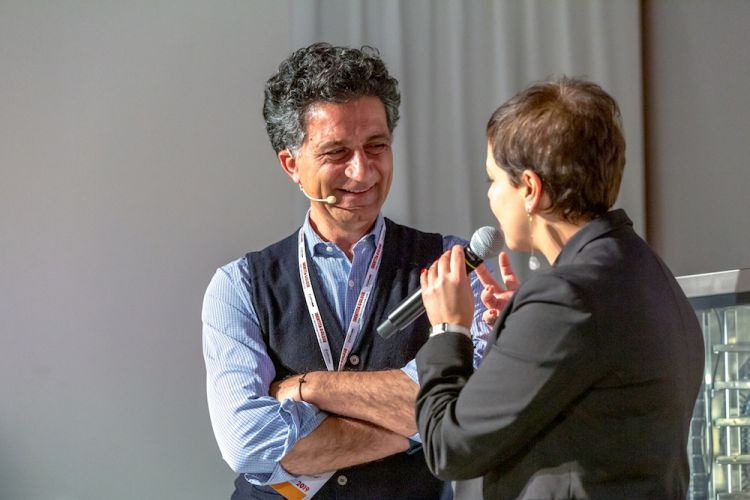«Every life is born from a seed. The seed is a project. Inside it, there’s the dream of our ancestors. In the dream enclosed in the seed, there’s the entire drama of creation». Giuseppe Li Rosi chooses a lyric approach to present the new memories of the earth that he’s building with the 170 members of Simenza, Compagnia siciliana di sementi contadine.
With him, there’s Tommaso Cannata.The greatest baker in Messina (with a branch in Milan too, since one year and a half ago) shows the dream in which a seed has already been transformed: the loaves of bread made with Miscuglio evolutivo which – together with Tumminia flour«when it’s the real one, when it’s the good one» - is already becoming his favourite type of flour.

The two speakers with Francesca Barberini, who as usual hosted Identità di Pane e Pizza
Thanks to them, the afternoon at
Identità di Pane e Pizza started with the huge emotion that only the powerful and evocative liturgy of broken bread can move through the heart, even more importantly than through its aroma and flavour: the gift of a unique sharing and of an authentic lesson of life.
The first gift is given by Tommaso Cannata who, unexpectedly, doesn’t just give the audience a sample of food to taste, but a handful of mother yeast for them to keep: «I inherited this mother yeast from my father, I’ve preserved it throughout my life and now I’ve handed it to my son. I’m not jealous, but it’s important that you know it’s part of my family. So I ask you to take it home with you only if you believe you’ll pay it the attention it deserves».
This is enough to show how Tommaso is a baker with a very traditional approach, a very generous soul and a farsighted attitude. «My innovation is just a return to the past», is something he often repeats: «You can invent many things, but many have already been invented, and we just need to remember how to do them». This is what he’s done himself: fourth generation of bakers, he grew up always with his finger in the pie, even when as a kid he started to wonder what was in the flour sacks that arrived at the bakery and which every night his father transformed into loaves of bread: where did that wheat come from? What seeds had been used? How did they grow, and who milled it?

The mother yeast that Cannata offered to everyone in the audience who felt «they could look after it with the respect it deserves»
«Fifteen years ago I went to the countryside, in Sicily. Since I had studied a little history I started to wonder something else: where had the so called granary of Italy gone?». In those fields I met Giuseppe Li Rosi, who in the meantime had started to work at the Centro di Granicoltura in Sicily and with him a long and promising collaboration was born that today has finally made the island aware of the value of the famous 52 ancient varieties - 48 of durum wheat, 4 of tender wheat – that have once again been mapped and planted.
And it’s Li Rosi who offers the second gift to bring home and nourish together with the yeast: «A story that shows to humanity that there’s still another stage, beyond resilience: something we learnt from wheat itself».

Giuseppe Li Rosi and Francesca Barberini
This is how
Miscuglio evolutivo was born. Today, thanks to the partnership with
Molino Quaglia, it has become the
Petra Evolutiva flour. By now it is commonly known that it is the result of the experiments made by
Simenza, by planting in a fully organic evolutionary field 1994 varieties of tender wheat (with 750 crossbreeds!). What’s less known is their origin. «That mix – said
Li Rosi – arrived from Aleppo, right before the war in Syria. There used to be a research centre there, called
Icarda, which has now moved to Morocco. When the fights began, agricultural machines would be stolen, because they could easily pass through checkpoints without drawing attention. At one point they realised that all that was kept at
Icarda had to be saved. And 90 kg of those seeds arrived here».
Resilience is when an experience is born from a tragedy: «When we planted them, that field of wheat was the very opposite of what that they had induced us to imagine, with perfectly identical spikes, and every anomaly considered as a mistake. This is still the case. Every spike is different and each one learns to express itself next to the other, because each one knows that inter-specific competition could lead to extinction, while cooperation will lead to co-evolution».
So on top of resilience, there’s something more: «Anti-fragility, which, in the words of Taleb, goes beyond resilience and robustness: a resilient being, resists to shocks while remaining identical, whereas an antifragile being improves. So this is how the Grano della Pace, the Wheat of Peace, was born. Nature is our greatest teacher of how to handle every crisis, and this should tell us a lot in terms of life and our model of society».
«The work done in a field of evolutionary wheat grains and the work done with yeast - Li Rosi and Cannata say at the end – are then solidified by fire to become bread». And so be it.
Translated into English by Slawka G. Scarso